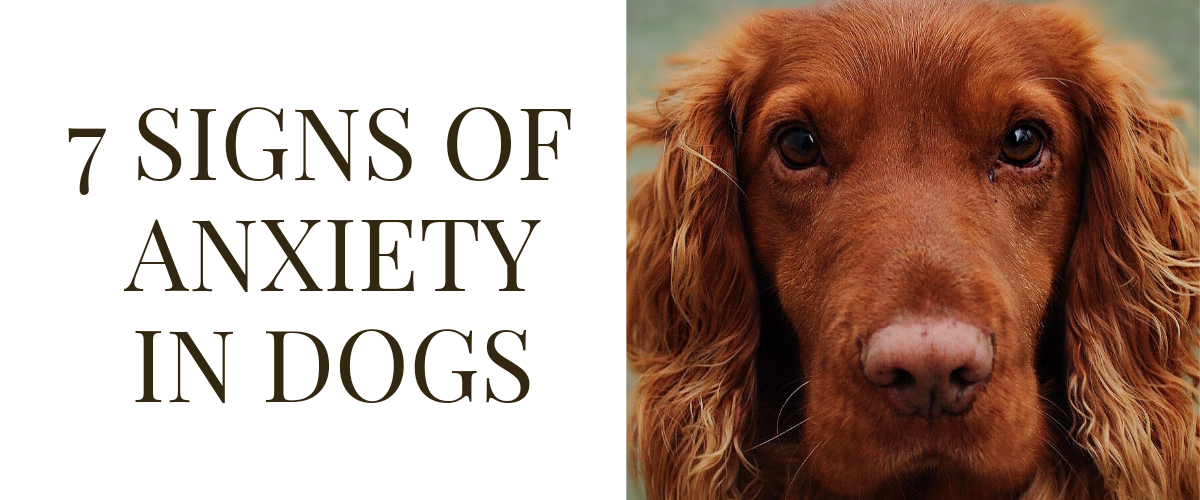If you want to resolve situations that make your dog anxious and bored at first you need to understand your dog behavior.

It’s vital to understand and recognize the signs of anxiety in our pets. Dogs, just like us, can experience stress and anxiety, and it’s crucial responsibility to provide them with the care and support they need. In this blog post, we will explore 7 Signs of dog anxiety and stress, and offer tips to Calm dog anxiety
Understanding your dog’s body language is crucial for recognizing subtle signs of anxiety. Dogs communicate through their whole body, and being aware of their signals can help you identify when they’re feeling stressed or anxious.
Table of Contents
Toggle7 Signs Of Dog Anxiety
Restlessness:
One of the most apparent signs of anxiety in dogs is pacing or restlessness. An anxious dog may repeatedly walk back and forth in a certain area or around the house. This behavior is often accompanied by an inability to settle down or find a comfortable position.
Excessive Panting:
If your dog is exhibiting excessive panting or drooling that is out of the ordinary, it could be a sign of anxiety. When dogs feel anxious, their heart rate increases, leading to heavier breathing and drooling. Keep an eye out for these symptoms, especially if they occur in stressful situations like thunderstorms or during visits to the veterinarian.
Excessive Barking:
Anxiety can cause dogs to vocalize more than usual. Excessive barking or whining, especially when accompanied by other signs of distress, could be an indicator that your dog is feeling anxious. It’s important to pay attention to the context of the behavior to determine if it is anxiety-related or a response to a specific trigger.
Destructive behavior:
An anxious dog may resort to destructive behavior as a way to alleviate their anxiety. This can include chewing on furniture, shoes, or other household items. Dogs may also scratch at doors, dig at carpets, or exhibit other forms of destructive behavior when they feel stressed or anxious.
Trembling or shaking:
Trembling or shaking is a physical manifestation of anxiety in dogs. It can range from subtle shivering to more pronounced shaking. Dogs may tremble or shake when they are exposed to loud noises, new environments, or when they are separated from their owners.
Avoidance or hiding:
When dogs feel anxious, they may exhibit avoidance behavior or try to hide. They may seek out secluded areas, such as under furniture or in corners, in an attempt to create a safe space. If your dog suddenly starts hiding or avoiding certain areas, it could be a sign of anxiety.
Changes in appetite or digestive issues: Anxiety can also affect a dog’s appetite and digestive system. Some dogs may experience a loss of appetite or eat less when they are feeling stressed. On the other hand, others may engage in “stress eating” and consume more food than usual. Additionally, anxiety can lead to digestive issues such as diarrhea or vomiting.
How to Help Your Anxious Dog:
Recognizing the signs of anxiety in your dog is crucial, but it’s equally important to provide them with the help and support they need.
Here are a few strategies to assist your anxious furry friend:
Create a safe environment:
Designate a quiet and comfortable area in your home where your dog can retreat when they feel anxious. Provide them with a cozy bed, toys, and familiar scents to create a sense of security.
Regular exercise and mental stimulation:
Engaging your dog in regular exercise and mental stimulation can help reduce their anxiety levels. Physical activity helps release pent-up energy, while mental stimulation through puzzle toys or training exercises can redirect their focus and provide a positive outlet for their anxiety.
Counter-conditioning and desensitization:
If your dog is anxious in specific situations, such as car rides or thunderstorms, gradual exposure and positive reinforcement can help them overcome their fears. Start by exposing
FAQs
Q: What are signs of anxiety in dogs?
A: Signs of anxiety in dogs include restlessness, excessive panting, barking or whining, destructive behavior, trembling, avoidance or hiding, changes in appetite, and digestive issues.
Q: How do you relieve a dog’s anxiety?
A: To relieve a dog’s anxiety, create a safe environment, provide regular exercise and mental stimulation, consider behavioral training, use calming aids or supplements (under veterinary guidance), and seek professional help if needed.
Q: Why is my dog very anxious all of a sudden?
A: Sudden anxiety in dogs can be caused by various factors, such as a change in environment, traumatic experiences, medical conditions, aging, or genetic predisposition. Identifying the underlying cause is crucial for addressing the sudden anxiety.
Q: What triggers dog’s anxiety?
A: Common triggers for dog anxiety include loud noises (thunderstorms, fireworks), separation from owners, unfamiliar environments, certain social situations, previous traumatic experiences, or changes in routine.
Q: Are anxious dogs unhappy?
A: Anxiety in dogs can significantly impact their well-being and quality of life. While it doesn’t necessarily mean they are constantly unhappy, managing their anxiety is essential to ensure their overall happiness and contentment.
Q: How long does dog anxiety last?
A: The duration of dog anxiety can vary depending on the trigger, severity, and management approach. It can last for minutes to hours or persist for longer periods if left unaddressed. Timely intervention and consistent management can help reduce the duration of anxiety episodes.
Q: What age do dogs get anxiety?
A: Dogs can experience anxiety at any age. However, certain life stages, such as puppyhood or adolescence when they are learning and adapting to new experiences, can be more prone to anxiety. Older dogs may also develop anxiety due to cognitive decline or health issues.
Q: How do I know if my dog is depressed?
A: Signs of depression in dogs may include decreased appetite, lethargy, loss of interest in activities, withdrawal from social interaction, changes in sleep patterns, and excessive vocalization. Consult with a veterinarian to assess your dog’s behavior and determine if depression is the cause.
Q: What are the first signs of stress in a dog?
A: The first signs of stress in dogs may include increased panting, lip licking, yawning, trembling, dilated pupils, excessive shedding, lowered tail position, flattened ears, or attempts to escape or hide.
Q: What age do dogs relax?
A: Dogs may start to relax and exhibit calmer behavior as they mature into adulthood, typically around 2 to 3 years of age. However, individual personalities and experiences can influence relaxation levels, and some dogs may naturally have a more relaxed temperament than others.
Q: Do anxious dogs live long?
A: Anxiety itself does not directly affect a dog’s lifespan. However, prolonged or severe anxiety can lead to other health issues if left unmanaged. With proper care, treatment, and a supportive environment, anxious dogs can live fulfilling lives similar to their non-anxious counterparts.




